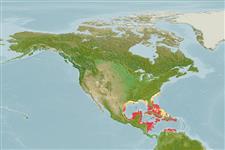分類 / Names
俗名 | 同種異名 | Catalog of Fishes(屬, 種) | ITIS | CoL | WoRMS | Cloffa
Elasmobranchii
板鰓亞綱 (鯊魚與魟魚) (sharks and rays) >
Myliobatiformes (Stingrays) >
Urotrygonidae (American round stingrays)
Etymology: Urobatis: Greek,oura = tail + Greek, batis, batidos = a ray (Raja sp.) (Ref. 45335).
More on author: Cuvier.
Environment: milieu / climate zone / depth range / distribution range
生態學
海洋 礁區魚類; 深度上下限 1 - 25 m (Ref. 9710). 熱帶; 37°N - 7°N, 100°W - 59°W (Ref. 55316)
Western Atlantic: North Carolina, USA to northern South America. Also in Bahamas, Yucatan and throughout Caribbean (Ref. 26938).
西大西洋: 美國北卡羅萊那州到南美洲北部。 也在巴哈馬, 尤卡坦半島與在加勒比海各處.(參考文獻 26938)
大小 / 重量 / 年齡
Maturity: Lm ? range ? - ? cm
Max length : 76.0 cm TL 雄魚/尚未辨別雌雄; (Ref. 9710)
簡短描述
型態特徵 | 形態測量圖
Edge of disk no sharp angles, no dorsal fin. Well-developed caudal fin extends around tip of tail, doubly serrate spine near caudal fin base (Ref. 26938). Disk yellowish, with dark vermiculations and spots that form a variety of patterns on upper surface (Ref. 7251). Lower surface is yellowish, greenish or brownish white, tail with dark spots (Ref.6902).
圓盤的邊緣沒有銳角, 沒有背鰭。 發展良好的尾鰭延伸尾尖的周圍, 在尾鰭基底附近的二倍鋸齒狀的棘.(參考文獻 26938) 圓盤淡黃色的, 有深色的蠕蟲爬跡形的裝飾與斑點在上表皮上形成一個變異的樣式.(參考文獻 7251) 下表面是淡黃色的﹐呈綠色的或者白褐色的, 尾部有深色的斑點.(參考文獻 6902)
Commonly found along sandy beaches to the water's edge, and especially in sandy areas in and around coral reefs (Ref. 7251). Raises front end of disc to attract prey seeking shelter (Ref. 7251). Feeds on shrimps, probably also on small fishes, clams, and worms (Ref. 12951). Known to be capable of inflicting dangerous wounds with its venomous spine. Easily approached (Ref. 9710). A live-bearing species, produces 3 to 4 young (Ref. 26938).
普遍地棲息於沿著沙灘到水的邊緣, 與尤其在珊瑚礁的裡面與周圍的沙地中.(參考文獻 7251) 舉起體盤的前端吸引尋找庇護所的獵物.(參考文獻 7251) 吃蝦, 可能也捕食小魚,蛤,與蠕蟲.(參考文獻 12951) 已知能夠施放危險的創傷用它的有毒棘。 容易接近。 (參考文獻 9710) 一個胎生或卵胎生種, 生產 3 到 4個幼魚。 (參考文獻 26938)
Life cycle and mating behavior
成熟度 | 繁殖 | 產卵場 | 卵 | 孕卵數 | 仔魚
Male grasps disc margin of female, swings under her and inserts a clasper. Mating pair is surrounded by other males that swim around and nudge them. Dugger (1987) (Ref. 51118) observed both male and female biting the pectoral fin of its mate (Ref. 49562).西大西洋: 美國北卡羅萊那州到南美洲北部。 也在巴哈馬, 尤卡坦半島與在加勒比海各處.(參考文獻 26938)
Compagno, L.J.V., 1999. Checklist of living elasmobranchs. p. 471-498. In W.C. Hamlett (ed.) Sharks, skates, and rays: the biology of elasmobranch fishes. Johns Hopkins University Press, Maryland. (Ref. 35766)
人類使用
水族館: 公眾的水族館
更多資訊
年龄/大小成長長度-重量長度-長度長度-頻率形態測量圖型態特徵仔魚稚魚動力學入添量豐度BRUVS
參考文獻養殖養殖資訊品種遺傳學Electrophoreses遺傳率疾病加工NutrientsMass conversion
合作者照片Stamps, Coins Misc.聲音神經毒速度泳型鰓區Otoliths腦重體重比眼睛色素
工具
特別的報告
下載 XML
網路資源
Estimates based on models
Preferred temperature (Ref.
123201): 25.8 - 28.1, mean 27.3 °C (based on 482 cells).
Phylogenetic diversity index (Ref.
82804): PD
50 = 0.5078 [Uniqueness, from 0.5 = low to 2.0 = high].
Bayesian length-weight: a=0.01072 (0.00570 - 0.02016), b=3.03 (2.86 - 3.20), in cm total length, based on LWR estimates for this species & (Sub)family-body (Ref.
93245).
營養階層 (Ref.
69278): 3.6 ±0.51 se; based on food items.
回復力 (Ref.
120179): 非常低的, 最小族群倍增時間超過14 年 (Preliminary K or Fecundity.).
Fishing Vulnerability (Ref.
59153): Moderate to high vulnerability (50 of 100).
Nutrients (Ref.
124155): Calcium = 7.17 [0.77, 112.55] mg/100g; Iron = 0.376 [0.030, 3.868] mg/100g; Protein = 20.4 [15.0, 25.6] %; Omega3 = 0.069 [0.021, 0.205] g/100g; Selenium = 24.1 [4.1, 110.7] μg/100g; VitaminA = 47.1 [3.2, 591.0] μg/100g; Zinc = 0.963 [0.062, 10.956] mg/100g (wet weight);
